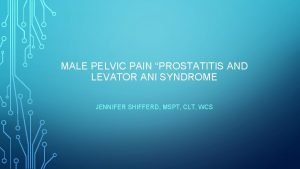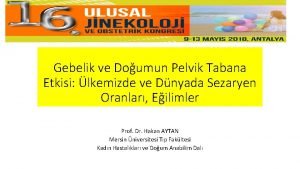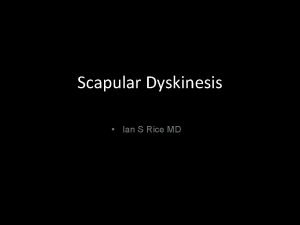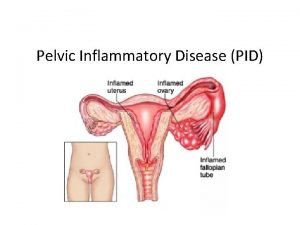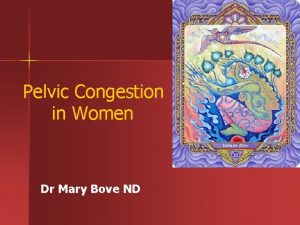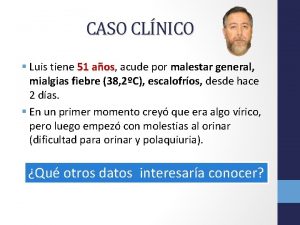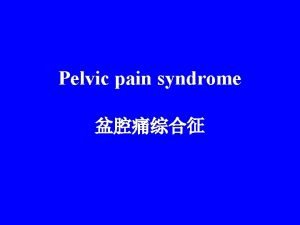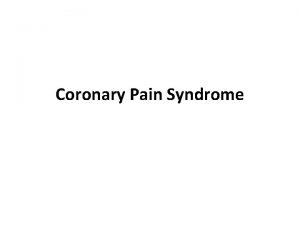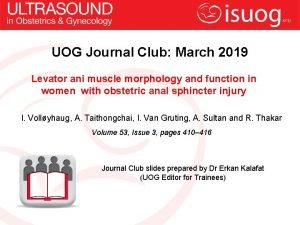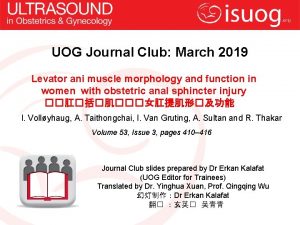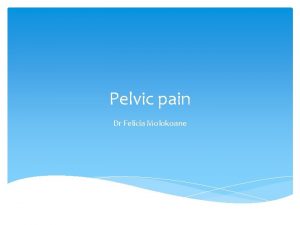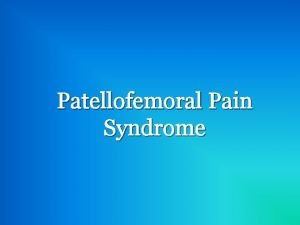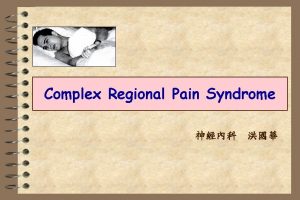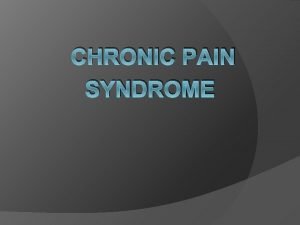MALE PELVIC PAIN PROSTATITIS AND LEVATOR ANI SYNDROME













- Slides: 13

MALE PELVIC PAIN “PROSTATITIS AND LEVATOR ANI SYNDROME JENNIFER SHIFFERD, MSPT, CLT, WCS

MALE PELVIC FLOOR DYSFUNCTIONS • Levator Ani Syndrome- spasm of deepest muscle layer • • Symptoms include pain, pressure or ache in vagina and rectum • Repeated straining during defecation can promote pain/throbbing • Men often misdiagnosed with prostatitis Referred pain to thigh, coccyx, sacrum, lower abdomen and to tip of penis, urethra • Can lead to erectile, urinary dysfunction and bowel dysfunction

MALE PELVIC FLOOR DYSFUNCTION • Prostatitis • 95 percent of cases of chronic prostatitis in men is nonbacterial 1, and could indeed have a musculoskeletal origin. • Dysfunction and spasm of the pelvic floor muscles can cause symptoms that mimic prostatitis by causing pain and urinary symptoms. http: //physical-therapy. advanceweb. com/Features/Article-1/A-Male-Malady. aspx 1. Nickel, J. C. et al. Prevalence of prostatitis-like symptoms in a population based study using the national Institutes of Health chronic prostatitis symptom index. J Urol, (2001)165: 842.

CHRONIC PROSTATITIS • NIH classified prostatitis into four categories: • • Category I: Acute Bacterial Prostatitis Category II: Chronic Bacterial Prostatitis Category III: Chronic Prostatitis / Chronic Pelvic Pain Syndrome Category IV: Asymptomatic Prostatitis

CHRONIC PROSTATITIS / CHRONIC PELVIC PAIN SYNDROME • Chronic Pelvic Pain Syndrome is a nonbacterial infection but is often treated as such. • Primary symptoms; discomfort and pain • Pain locations: pelvic floor, perineum, rectum, coccyx (tail bone), prostate, penis, testicles/scrotum, groin, thighs, lower abdomen, and low back

CHRONIC PROSTATITIS / CHRONIC PELVIC PAIN SYNDROME • Sexual dysfunction can include painful ejaculation, premature ejaculation, erectile dysfunction, and decreased libido • Erectile dysfunction reported in 43% of patients, with 45% of patients reporting exacerbation of pain during or after intercourse • 62 patients with pelvic pain syndrome, 52 were found to have tenderness and spasm in pelvic muscles around prostate and anterior pelvis per digital rectal exam

CHRONIC PROSTATITIS / CHRONIC PELVIC PAIN SYNDROME • Erectile function; adequate amount of blood must flow into penis and must be trapped to maintain rigidity • Bulbospongiosus and ischiocavernosus muscles are involved • Bulbospongiosus blocks blood from escaping by pressing on the deep dorsal vein of the penis • Need adequate contraction of muscles to maintain erection • Erectile Dysfunction; can result from muscle spasm and weakness

CHRONIC PROSTATITIS / CHRONIC PELVIC PAIN SYNDROME • Painful ejaculation; levator ani muscle trigger points can refer pain to tip of penis and urethra • Chronic pelvic pain can lead to decreased libido • Goal for patient- to learn how to relax their pelvic floor musculature

CHRONIC PROSTATITIS / CHRONIC PELVIC PAIN SYNDROME • Premature ejaculation; can be result of pelvic floor muscle weakness • Increasing awareness of the pelvic floor musculature through physical therapy is a start • Strengthening is a key component to success

CHRONIC PROSTATITIS / CHRONIC PELVIC PAIN SYNDROME • Urinary Dysfunction; voiding dysfunctions such as dysuria, urgency and frequency • Chronic pelvic floor muscle tension can compromise urine flow by constricting urethral sphincters, resulting in weak stream and difficulty initiating voiding • Urgency- straining to void to fully empty further aggravates a tight pelvic floor leading to a perpetuating cycle

CHRONIC PROSTATITIS / CHRONIC PELVIC PAIN SYNDROME • Bowel Dsyfunction; repetitive straining to empty bowels can further aggravate pelvic floor muscle spasm, if prolonged can disrupt normal defecation mechanics and lead to pelvic organ prolapse

CHRONIC PROSTATITIS / CHRONIC PELVIC PAIN SYNDROME • ASSESSMENT: • Pelvic floor examination- to assess for trigger points of the levator ani and ischiocavernosus musculature, ability to isolate and contract pelvic floor, pelvic floor muscle strength • Muscle coordination; check for good relaxation and perineal descent with simulated defecation to rule out dyssynergia

CHRONIC PROSTATITIS / CHRONIC PELVIC PAIN SYNDROME • TREATMENT: • • If infection is ruled out then referral to physical therapy is recommended • • Initial treatment is manual therapy; trigger point releases, prolonged gentle stretching • Home program for symptom management Physical Therapy will help to teach patient how to relax their pelvic floor and better isolate once strengthening is indicated Modalities for pain, inflammation reduction SEMG to assist with pelvic floor isolation, recruitment, relaxation Core strengthening once pelvic floor muscle spasm has reduced and no pain with contraction
 Levator ani syndrome
Levator ani syndrome Pelvik
Pelvik Centrum tendineum diaphragma
Centrum tendineum diaphragma Musculus ani
Musculus ani De ani si ani cadeti in hau
De ani si ani cadeti in hau Ani woda ani dropsy nie smakuja tak jak koksy
Ani woda ani dropsy nie smakuja tak jak koksy Pelvic pain meaning
Pelvic pain meaning Scapular pain
Scapular pain Pelvic girdle pain
Pelvic girdle pain Pelvic girdle pain
Pelvic girdle pain Essential oils for pelvic congestion syndrome
Essential oils for pelvic congestion syndrome Amoxiclav
Amoxiclav Clasificacion prostatitis
Clasificacion prostatitis Prostate gland mri
Prostate gland mri
